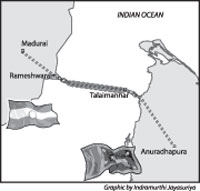
Undersea power to Sri LankaGestation period of forty two months The proposed India-Sri Lanka Electricity Grid Interconnection project which aims to lay an undersea power line between Rameshwaran in South India and Talaimannar could be commissioned within 42 months from the inception of the work on the project, according to the pre-feasibility report on it. It has been estimated that the project will cost around Rs 4.8 billion. The basis for the cost estimates have been based on quotations from leading HVDC (high voltage. direct current) equipment manufacturers in Sweden, France and Germany.
The pre-feasibility report is to be followed up by a full feasibility study to be undertaken jointly by the two countries shortly, The Sunday Times learns. According to the pre feasibility report, the proximity of the location of India and Sri Lanka provides for the opportunity of power exchange between these two countries through transmission interconnection. The power supply position of India is envisaged to improve with the commissioning of planned capacity additions, especially in the southern region which is expected to have a large quantum of surplus supplies between 2011 and 2012, reaching a peak surplus of around 6000 MW and an off peak surplus of 12,300 MW. The interconnection of the southern grid with Sri Lanka shall help in enlarging the power market reach for generation projects in India to export power from India to Sri Lanka while Sri Lanka shall have access to the competitive power availability in the Indian power market, the Report said. Sri Lanka, at present is dominated by hydro power (50 per cent) but this hydro dominance would reduce progressively in future as the future generations are mainly thermal based. India on the other hand has a substantial amount of hydro based generation (overall 26 per cent) The Report said that the transfer of power from India to Sri Lanka would also reduce the use of expensive thermal generation in Sri Lanka based on liquid fuels.Thus the link will be mutuality beneficial to both the countries with Sri Lanka achieving significant savings on cost by importing cheaper power from India while India would benefit from having access to newer market to sell surplus power. The power supply scenario of both countries suggests that in the short term period (2009-2010), India and Sri Lanka can exchange power to the tune of about 500 MW. The quantum of power exchange can be enhanced to about 1000 MW in the medium time period (2011-2012) when both the countries would have reasonable experience in exchange of power as well as a comfortable power supply scenario. As of now, with the projected power scenario, it is envisaged to retain the capacity of exchange of power of 1000 MW in the long term as well (2015-2016). While planning the interconnection, flexibility need to be provided so that either side can transfer power up to 1000 MW depending upon the availability and demand for power, the Report said. The transmission system between India and Sri Lankan need to be planned judiciously as it would involve expensive submarine cables. The transmission line would be 400 KV HVDC overhead lines from Madurai to the Indian coast (near Rameshwaram (139 km), a 400 KV HVDC cable from the Indian sea coast to the Sri Lankan sea coast (39 km), a 400 KV HVDC overhead line from the Sri Lankan coast to Anuradhapura/Puttalam (125km). A detailed marine survey is to be carried out prior to the laying of the undersea/submarine cables. The cable survey will look into the traffic of movements of ships in the area, depth of sea, earthquake zones and volcanic actives as well as the presence of sharks in that area of sea. |
|
||||||
|| Front
Page | News | Editorial | Columns | Sports | Plus | Financial
Times | International | Mirror | TV
Times | Funday
Times || |
| |
Reproduction of articles permitted when used without any alterations to contents and a link to the source page.
|
© Copyright
2008 | Wijeya
Newspapers Ltd.Colombo. Sri Lanka. All Rights Reserved. |
